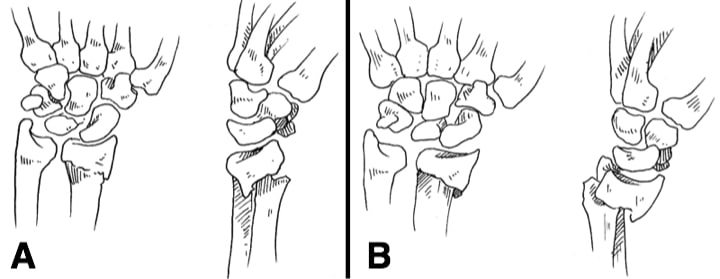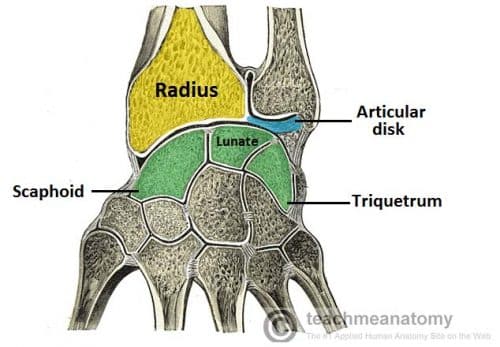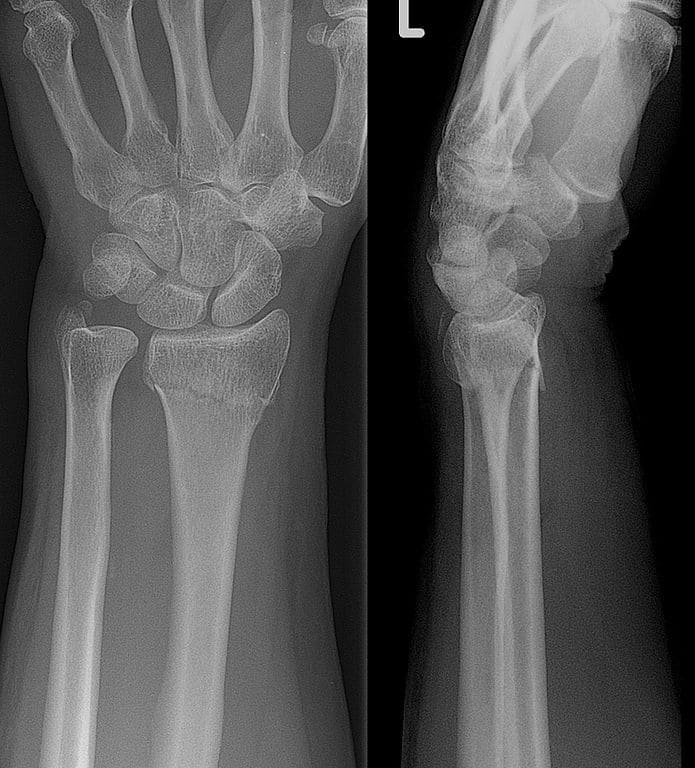Fractures of the distal radius represent a quarter of all fractures seen clinically. The fractures occur through the distal metaphysis of the radius, with or without articular surface involvement.
The correct diagnosis and management of these fractures is crucial, as incorrect management may result in loss of normal wrist function, with significant implications on functional status and quality of life.
This article will name and focus on the three most common eponymous distal radius fracture types, the Colles’ fracture, the Smith’s fracture, and the Barton’s fracture. The Colles’ fractures are the most common type of wrist fracture, accounting for 90% of all distal radius fractures.
Pathophysiology
Distal radius fractures are most commonly caused by a fall on an outstretched hand (FOOSH). Due to osteoporosis, the risk of these fractures increases with age (termed ‘fragility fractures’). However, children between 5-15yrs are also prone to these fractures.
The distal radius takes 80% of the axial load underneath the scaphoid and lunate fossae. A FOOSH causes a forced supination or pronation of the carpus; this in turn increases the impaction load of the distal radius.
Classification
Colles’ Fracture
A Colles’ fracture* describes an extra-articular fracture of the distal radius with dorsal angulation and dorsal displacement, within 2cm of the articular surface. This type of fracture typically occurs as a “fragility fracture” in osteoporotic bone.
It occurs when a person falls forwards and plants their outstretched hand in front of them. The transfer of load as their body falls forces the wrist into supination (Fig. 2A).
*By definition, a Colles’ fracture also includes an avulsion fracture of the ulnar styloid, however this feature may not always be present in those described as such
Smith’s Fracture
This describes the volar angulation of the distal fragment of an extra-articular fracture of the distal radius (the reverse of a Colles fracture), with or without volar displacement.
This type of fracture is caused by falling backwards and planting the outstretched hand behind the body, causing a forced pronation type injury (Fig. 2B). These are less common.
Barton’s Fracture
This is an intra-articular fracture of the distal radius with associated dislocation of the radio-carpal joint.
A Barton fracture can be described as volar (more common) or dorsal (less common), depending on whether the volar or dorsal rim of the radius is involved.

Figure 2 – Schematic demonstrating difference in mechanism of injury and bony injury between (A) Colles’ fracture (B) Smith’s fracture
Risk Factors
The main risk factors for distal radius fractures are related to osteoporosis:
- Increasing age
- Female gender
- Early menopause
- Smoking or alcohol excess
- Prolonged steroid use
Clinical Features
Patients with a distal radius fracture typically present following an episode of trauma, complaining of immediate pain +/- deformity and sudden swelling around the fracture site. Any neurological involvement can also result in paresthesia or weakness.
On examination, it is important to assess for any evidence of neurovascular compromise;check nerve function (see below) and limb perfusion (capillary refill time and pulses). Additionally, remember to examine the joints above and below to identify occult injuries.
Neurological Examination
The neurological examination for a suspected distal radius fracture should include the following nerves being assessed:
- Median nerve: motor – abduction of the thumb; sensory – radial surface of distal 2nd digit
- Anterior interosseous nerve: opposition of the thumb and index finger*
- Ulnar nerve: motor – adduction of the thumb (‘Froment’s Sign’); sensory – ulnar surface of the distal 5th digit
- Radial nerve: motor – extension of IPJ of thumb; sensory – dorsal surface of 1st webspace
*Ask for an ‘okay’ sign, if the DIPJ of the 2nd digit and IPJ of thumb extend, this signifies AIN nerve involvement
Differential Diagnosis
- Forearm fracture (such as Galeazzi or Monteggia fractures)
- Carpal bone fractures
- Tendonitis or tenosynovitis
- Wrist dislocation
Investigations
Plain radiographs are the quickest and definitive investigations of most fractures (Fig. 3). Three measurements on a plain radiograph help with the diagnosis of a distal radius fracture:
- Radial height <11mm
- Radial inclination <22 degrees
- Radial (volar) tilt >11 degrees
Further CT or MRI imaging may be used in more complex distal radius fractures, particularly for operative planning, however this can be performed once initial management steps have been made.
Management
As for any trauma case (beyond the scope of this article), suitable resuscitate and stabilisation of the patient is the priority.
Once stabilised, all displaced fractures require closed reduction in the emergency department. Various techniques can be employed, however all involve ensuring sufficient traction and manipulation under anaesthetic. This can be performed under conscious sedation with a haematoma block or Bier’s block.
Following reduction, the arm should be restricted to allow for bone healing. Stable and successfully reduced fractures can typically be placed in a below-elbow backslab cast, then radiographs repeated after 1 week to check for displacement.
Once sufficient bone healing has occurred, patients should be rehabilitated via physiotherapy to ensure the regaining of full function.
Surgical Management
Significantly displaced or unstable fractures can require surgical intervention, as they have a risk of displacing further over time if not stabilised. Any fracture with an intra-articular step of the radiocarpal joint >2mm is also advised to be surgically corrected.
Options of surgical management include open reduction and internal fixation (ORIF) with plating, or K-wire fixation. External fixation is rarely used. Patients will be then placed in a cast to ensure ongoing immobility for a few weeks.
Complications
The main complications following distal radius fractures are:
- Malunion, whereby poor realignment leads to a shortened radius compared to the ulnar, leading to reduced wrist motion, wrist pain, and reduced forearm rotation; can be treated with corrective osteotomy of the malunion
- Median nerve compression, more common in patients who heal in a significant degree of malunion
- Osteoarthritis, especially with intra-articular involvement from the original fracture
Key Points
- Distal radius fractures are commonly caused by a fall on an outstretched hand, most commonly in those with osteoporosis
- The three most common eponymous distal radius fracture types are the Colles’ fracture, the Smith’s fracture, and the Barton’s fracture
- Ensure to assess neurovascular compromise in the initial assessment
- Radiographs are the mainstay of initial assessment of any suspected distal radius fracture
- All displaced fractures require closed reduction followed by more definitive and specialist management depending on type and severity


